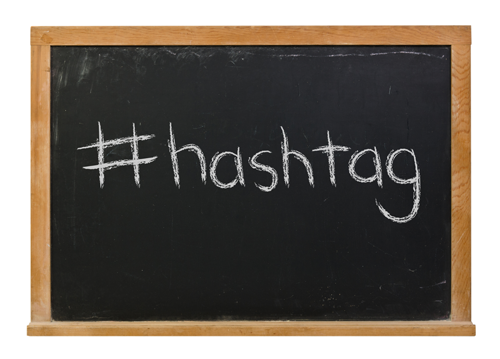
Instructor's Corner #3: #whoreallycaresabouthashtags: Using Twitter’s Hashtag to Foster an Interactive Environment
The interactive nature of hashtags offers students and teachers an exciting way to interact with one another in the classroom. The world outside the classroom already has discovered the interactive powers of the hashtag. For example, the hashtag symbol seems to be popping up everywhere, from Super Bowl ads to grandmas to churches. Even Jimmy Fallon is using hashtags on his show to communicate information about #Dadvice, #AwkwardBreakup, and #MyWeirdFamily, among many other topics. Hashtags, believe it or not, have their own set of hand motions, which have been eloquently demonstrated by Justin Timberlake and Jonah Hill.
While the hashtag initially appears to be all fun and games, some have argued the hashtag can be useful outside the comedic sphere. For example, the hashtag is used as a tool in activism, news reporting, and conversation organizing. With this widespread popularity and usefulness, the hashtag also can be used in education.
When I am teaching, I use Twitter and the hashtag to facilitate and encourage student-student interaction. To accomplish this, I first create an original hashtag, such as #SpeechClass14. I then ask students to use this hashtag in six tweets per week throughout the semester. The first tweet offers students a chance to apply what they are learning to something they read, listen to, or watch on TV, such as critiquing a recent news story. The second tweet is used to generate ideas, including topics for their next paper or speech. The third tweet is used just to talk about anything they find interesting or might be doing that day. The remaining three tweets are used to comment on their classmates’ tweets. By doing this activity, students begin interacting with one another about course content through the medium of Twitter.
I have found that students have responded positively to this activity. They enjoy being encouraged to interact with one another outside the classroom. This activity allows them to interact with one another about course content in the late hours of the night, on the weekends, and during a meal. The students have enjoyed talking to each other through Twitter, as this helps them feel less like classmates and more like friends.
Students also appreciate that the activity, while fostering interactions, is easy to accomplish. A 140-character tweet is non-threatening, offering students a chance to interact with one another without worrying about fellow students evaluating their writing or argumentation skills. It also doesn’t take much time to accomplish, and students have enjoyed the relaxed nature of this activity.
While students have enjoyed this activity, I personally have found it useful for two main reasons: First, students are talking about classroom content outside my class, actively engaged in applying what they are learning in the classroom to the world in which they live. For example, students talk to one another about future class assignments, and how best to accomplish these assignments with success and originality. A brief example of this interaction is seen below. (Please note that I have changed or omitted the profile names, and have changed the hashtag to a generic hashtag: #SpeechClass14.)
Student1: My Speech Is Going To Be About Human Trafficking In America. #SpeechClass14
Student2: @Student1 what will your main points be? #SpeechClass14
Student1: @Student2 1. What Is Human Trafficking?, 2. The Motives Behind Human Trafficking, 3.How It Affects Us As A Society #SpeechClass14
As the teacher monitoring the tweets, I was able to offer suggestions to Student1 about improving the organization of the speech. Observing the tweets also allows me to visibly see what concepts or assignments students do not understand. I can then use these tweet conversations as a foundation for my lesson plans, adding relevance to the content taught.
Second, this activity helps students talk to each other before class starts. Since they already have been interacting with each other on Twitter, it is easier and more natural for them to interact with each other prior to class time. It also allows me to talk to students while I set up the classroom. For example, if I observe students talking about the show Breaking Bad in some of their tweets, I can interact with these students about this subject.
This activity demonstrates how the hashtag can be used within a classroom, but I think it also demonstrates how versatile the hashtag has become. If used in a constructive manner, the hashtag offers another medium of communication. Workplaces, schools, and organizations everywhere might benefit from using the hashtag to facilitate interactions among members.
While Jimmy Fallon is using the hashtag to interact with his viewing audience, this activity uses the hashtag to cultivate an interactive environment in the classroom. Student-student and student-teacher interactions are important for the overall success of the classroom environment, and using the hashtag to foster these interactions is easy and enjoyable. The hashtag #SpeechClass14 probably won’t go viral anytime soon, but you will not see me complaining. #ThanksForReading #TheEnd

